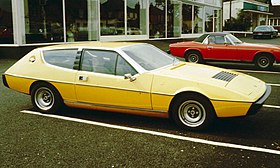Lotus Elite
| Lotus Elite Type 14 | |
|---|---|
 |
|
| Overview | |
| Manufacturer | Lotus Cars |
| Production | 1958–63 |
| Body and chassis | |
| Class | Sports car |
| Body style | 2-door coupé |
| Layout | Front-engine, rear-wheel-drive |
| Powertrain | |
| Engine | 1.2 L Coventry Climax Straight-4 75-105hp |
| Transmission | 4-speed manual |
| Dimensions | |
| Wheelbase | 2,242 mm (88.3 in) |
| Length | 3,759 mm (148.0 in) |
| Width | 1,506 mm (59.3 in) |
| Height | 1,181 mm (46.5 in) |
| Kerb weight | 503.5 kg (1,110 lb) |
| Chronology | |
| Successor | Lotus Elan |
| Lotus Elite Types 75 and 83 | |
|---|---|

Lotus Elite Type 75
|
|
| Overview | |
| Manufacturer | Lotus Cars |
| Production | 1974–82 2535 made |
| Body and chassis | |
| Class | Sports car |
| Body style | 2-door shooting brake or coupe |
| Layout | Front-engine, rear-wheel-drive |
| Related | Lotus Eclat |
| Powertrain | |
| Engine | 2.0-litre I4 2.2-litre I4 (from 1980) |
| Transmission | 4 or 5-speed manual 3-speed automatic |
| Dimensions | |
| Wheelbase | 2,490 mm (98 in) |
| Length | 4,470 mm (176 in) |
| Width | 1,820 mm (72 in) |
| Height | 1,210 mm (48 in) |
| Curb weight | 1,112 to 1,168 kg (2,452 to 2,575 lb) |
The Lotus Elite name has been used for two production vehicles and one concept vehicle from Lotus Cars. The first generation Elite Type 14 was produced from 1957 to 1963 and the second generation model (Type 75 and later Type 83) from 1974 to 1982. The Elite name was also applied to a concept vehicle revealed in 2010.
The first Elite or Lotus Type 14 was an ultra light two-seater coupé, produced from 1958 to 1963.
Making its debut at the 1957 London Motor Car Show, Earls Court, as chassis #1008 , the Elite had spent a year in development, aided by "carefully selected racing customers", before going on sale.
The Elite's most distinctive feature was its highly innovative fibreglass monocoque construction, in which a stressed skin GRP unibody replaced the previously separate chassis and body components. Unlike the contemporary Chevrolet Corvette, which used fibreglass for only exterior bodywork, the Elite also used this glass-reinforced plastic material for the entire load-bearing structure of the car, although the front of the monocoque incorporated a steel subframe supporting the engine and front suspension, and there was a hoop at the windscreen for mounting door hinges and jacking the car up. The first 250 body units were made by Maximar Mouldings at Pulborough, Sussex. The body construction caused numerous early problems, until manufacture was handed over to Bristol Aeroplane Company.
The resultant body was both lighter, stiffer, and provided better driver protection in the event of a crash. Sadly, the full understanding of the engineering qualities of fibreglass reinforced plastic was still several years off and the suspension attachment points were regularly observed to pull out of the fibreglass structure. The weight savings allowed the Elite to achieve sports car performance from a 75 hp (55 kW) 1216 cc Coventry Climax FWE all-aluminium straight-4 engine with fuel consumption at 35 mpg‑imp (8.1 L/100 km; 29 mpg‑US). All production Lotus Elites were powered by the FWE engine. (Popular mythology says that cars left the factory with a variety of engines, but this is incorrect.) The FWE engine, derived from a water pump engine usually found bolted to a fire truck, was used by Lucas Electric for electrical component life testing in the presence of intense vibration.
...
Wikipedia
